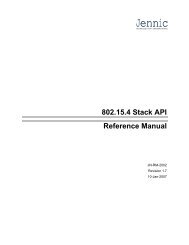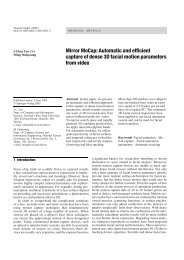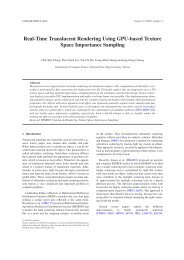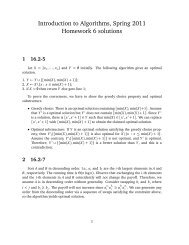Figure 34.10: Reducing circuit satisfiability to formula satisfiability ...
Figure 34.10: Reducing circuit satisfiability to formula satisfiability ...
Figure 34.10: Reducing circuit satisfiability to formula satisfiability ...
Create successful ePaper yourself
Turn your PDF publications into a flip-book with our unique Google optimized e-Paper software.
<strong>Figure</strong> <strong>34.10</strong>: <strong>Reducing</strong> <strong>circuit</strong> <strong>satisfiability</strong> <strong>to</strong> <strong>formula</strong> <strong>satisfiability</strong>. The <strong>formula</strong> produced bythe reduction algorithm has a variable for each wire in the <strong>circuit</strong>.The <strong>formula</strong> produced by the reduction algorithm is the AND of the <strong>circuit</strong>-output variablewith the conjunction of clauses describing the operation of each gate. For the <strong>circuit</strong> in thefigure, the <strong>formula</strong> is= x 10 x 4 x 3 )x 5 (x 1 x 2 ))x 6 x 4 )x 7 (x 1 x 2 x 4 ))x 8 (x 5 x 6 ))x 9 (x 6 x 7 ))x 10 (x 7 x 8 x 9 )).Given a <strong>circuit</strong> C, it is straightforward <strong>to</strong> produce such a <strong>formula</strong>in polynomial time.Why is the <strong>circuit</strong> C satisfiable exactly when the <strong>formula</strong> is satisfiable? If C has a satisfyingassignment, each wire of the <strong>circuit</strong> has a well-defined value, and the output of the <strong>circuit</strong> is 1.Therefore, the assignment of wire values <strong>to</strong> variables in makes each clause of evaluate <strong>to</strong>1, and thus the conjunction of all evaluates <strong>to</strong> 1. Conversely, if there is an assignment thatcauses <strong>to</strong> evaluate <strong>to</strong> 1, the <strong>circuit</strong> C is satisfiable by an analogous argument. Thus, we haveshown that CIRCUIT-SAT P SAT, which completes the proof.3-CNF <strong>satisfiability</strong>Many problems can be proved NP-complete by reduction from <strong>formula</strong> <strong>satisfiability</strong>. Thereduction algorithm must handle any input <strong>formula</strong>, though, and this requirement can lead <strong>to</strong> ahuge number of cases that must be considered. It is often desirable, therefore, <strong>to</strong> reduce from arestricted language of boolean <strong>formula</strong>s, so that fewer cases need be considered. Of course,we must not restrict the language so much that it becomes polynomial-time solvable. Oneconvenient language is 3-CNF <strong>satisfiability</strong>, or 3-CNF-SAT.We define 3-CNF <strong>satisfiability</strong> using the following terms. A literal in a boolean <strong>formula</strong> is anoccurrence of a variable or its negation. A boolean <strong>formula</strong> is in conjunctive normal form, orCNF, if it is expressed as an AND of clauses, each of which is the OR of one or more literals.A boolean <strong>formula</strong> is in 3-conjunctive normal form, or 3-CNF, if each clause has exactlythree distinct literals.
For example, the boolean <strong>formula</strong>(x 1 x 1 x 2 x 3 x 2 x 4 x 1 x 3 x 4 )is in 3-CNF. The first of its three clauses is (x 1 x 1 x 2 ), which contains the three literalsx 1 , x 1 , and x 2 .In 3-CNF-SAT, we are asked whether a given boolean <strong>formula</strong> in 3-CNF is satisfiable. Thefollowing theorem shows that a polynomial-time algorithm that can determine the<strong>satisfiability</strong> of boolean <strong>formula</strong>s is unlikely <strong>to</strong> exist, even when they are expressed in thissimple normal form.Theorem <strong>34.10</strong>Satisfiability of boolean <strong>formula</strong>s in 3-conjunctive normal form is NP-complete.Proof The argument we used in the proof of Theorem 34.9that SAT P 3-CNF-SAT.Lemma 34.8, we need only showThe reduction algorithm can be broken in<strong>to</strong> three basic steps. Each step progressivelytransforms the input <strong>formula</strong> closer <strong>to</strong> the desired 3-conjunctive normal form.The first step is similar <strong>to</strong> the one used <strong>to</strong> prove CIRCUIT-SAT P SAT in Theorem 34.9.First, we construct a binary "parse" tree for the input <strong>formula</strong> , with literals as leaves andconnectives as internal nodes. <strong>Figure</strong> 34.11 shows such a parse tree for the <strong>formula</strong>(34.3)<strong>Figure</strong> 34.11: The tree corresponding <strong>to</strong> the <strong>formula</strong> = ((x 1 x 2 x 1 x 3 x 4 x 2 .Should the input <strong>formula</strong> contain a clause such as the OR of several literals, associativity canbe used <strong>to</strong> parenthesize the expression fully so that every internal node in the resulting treehas 1 or 2 children. The binary parse tree can now be viewed as a <strong>circuit</strong> for computing thefunction.Mimicking the reduction in the proof of Theorem 34.9, we introduce a variable y i for theoutput of each internal node. Then, we rewrite the original <strong>formula</strong> as the AND of the root
which is equivalent <strong>to</strong> the original clause .Each clause of the <strong>formula</strong> ' has now been converted in<strong>to</strong> a CNF <strong>formula</strong> , and thus ' isequivalent <strong>to</strong> the CNF <strong>formula</strong> " consisting of the conjunction of the . Moreover, eachclause of " has at most 3 literals.The third and final step of the reduction further transforms the <strong>formula</strong> so that each clause hasexactly 3 distinct literals. The final 3-CNF <strong>formula</strong> "' is constructed from the clauses of theCNF <strong>formula</strong> ". It also uses two auxiliary variables that we shall call p and q. For eachclause C i of ", we include the following clauses in "':If C i has 3 distinct literals, then simply include C i as a clause of "'.If C i has 2 distinct literals, that is, if C i = (l 1 l 2 ), where l 1 and l 2 are literals, theninclude (l 1 l 2 p l 1 l 2 p) as clauses of "'. The literals p and ? p merelyfulfill the syntactic requirement that there be exactly 3 distinct literals per clause: (l 1l 2 p l 1 l 2 p) is equivalent <strong>to</strong> (l 1 l 2 ) whether p = 0 or p = 1.If C i has just 1 distinct literal l, then include (l p q l p q l pq l p q) as clauses of "'. Note that every setting of p and q causes theconjunction of these four clauses <strong>to</strong> evaluate <strong>to</strong> l.We can see that the 3-CNF <strong>formula</strong> "' is satisfiable if and only if is satisfiable byinspecting each of the three steps. Like the reduction from CIRCUIT-SAT <strong>to</strong> SAT, theconstruction of ' from in the first step preserves <strong>satisfiability</strong>. The second step produces aCNF <strong>formula</strong> " that is algebraically equivalent <strong>to</strong> '. The third step produces a 3-CNF<strong>formula</strong> "' that is effectively equivalent <strong>to</strong> ", since any assignment <strong>to</strong> the variables p and qproduces a <strong>formula</strong> that is algebraically equivalent <strong>to</strong> ".We must also show that the reduction can be computed in polynomial time. Constructing 'from introduces at most 1 variable and 1 clause per connective in . Constructing " from 'can introduce at most 8 clauses in<strong>to</strong> " for each clause from ', since each clause of ' has atmost 3 variables, and the truth table for each clause has at most 2 3 = 8 rows. The constructionof "' from " introduces at most 4 clauses in<strong>to</strong> "' for each clause of ". Thus, the size of theresulting <strong>formula</strong> "' is polynomial in the length of the original <strong>formula</strong>. Each of theconstructions can easily be accomplished in polynomial time.Exercises 34.4-1Consider the straightforward (nonpolynomial-time) reduction in the proof of Theorem 34.9.Describe a <strong>circuit</strong> of size n that, when converted <strong>to</strong> a <strong>formula</strong> by this method, yields a <strong>formula</strong>whose size is exponential in n.Exercises 34.4-2



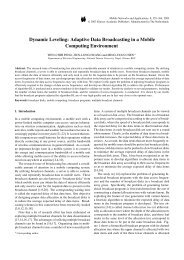
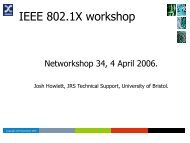

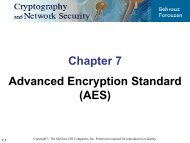
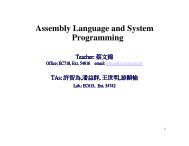
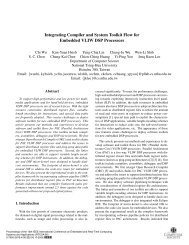
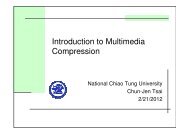

![Microsoft PowerPoint - 05_FTP.ppt [\254\333\256e\274\322\246\241]](https://img.yumpu.com/36298340/1/190x143/microsoft-powerpoint-05-ftpppt-254333256e274322246241.jpg?quality=85)
